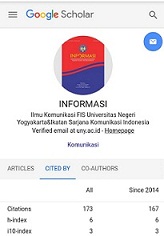Kartini in two lenses: The shifting image of Indonesian modern woman in R.A. Kartini (1982) and Kartini (2017)
Shofi Mahmudah Budi Utami, Universitas Jenderal Soedirman, Indonesia
Moh. Imam Subuhi, Universitas Jenderal Soedirman, Indonesia
Abstract
Keywords
Full Text:
PDFReferences
Adawiyah, R., & Rachmaria, L. (2021). Mitos “Kanca Wingking” Perempuan Jawa dalam Film Kartini. PANTAREI, 5(02). https://jom.fikom.budiluhur.ac.id/index.php/Pantarei/article/view/746
Ade, R. N. A. T. (2020). Campur Kode Bahasa Indonesia pada Tuturan Berbahasa Jawa dalam Film Kartini Karya Hanung Bramantyo. Aksara: Jurnal Ilmiah Pendidikan Bahasa Dan Sastra Indonesia, 3(2), 133–140. https://doi.org/10.33087/AKSARA.V3I2.127
Amalia, L. S. (2010). Kiprah Perempuan di Ranah Politik dari Masa ke Masa – PUSAT RISET POLITIK. https://politik.brin.go.id/kolom/etnisitas-gender-agama/kiprah-perempuan-di-ranah-politik-dari-masa-ke-masa/
Asyraf, M. A., & H.A., S. H. (2020). Mode of The Domestication of Women in Indonesian Political System | Balairungpress. https://www.balairungpress.com/2020/04/mode-of-the-domestication-of-women-in-indonesian-political-system/
Bramantyo, H. (2017). Kartini. Legacy Pictures.
Chen, J. (2022). Millennials: Finances, Investing, and Retirement. https://www.investopedia.com/terms/m/millennial.asp
Chin, G. V. S. (2018). State Ibuism and One Happy Family: Polygamy and the “Good” Woman in Contemporary Indonesian Narratives. In G. V. S. Chin & K. Mohd Daud (Eds.), The Southeast Asian Woman Writes Back (pp. 89–106). Springer Singapore. https://doi.org/10.1007/978-981-10-7065-5_6
Ferber, M. (2007). A Dictionary of Literary Symbols Second Edition (2nd Ed). Cambridge University Press Cambridge.
Hasanah, A., & Witarti, D. I. (2018). Representasi Bakti Kartini pada Orang Tua dalam Film Kartini ( Analisis Semiotika atas Film Kartini ). PANTAREI, 4(2), 1–9.
IMDb. (2017). Kartini. IMDb. https://www.imdb.com/title/tt5882416/?ref_=nv_sr_srsg_0
IMDb. (2022). Raden Ajeng Kartini (1989). IMDb. https://www.imdb.com/title/tt0337076/
Kartini, R. A., & Coté, J. (2021). Kartini: The Complete Writings 1898-1904. Kartini. https://doi.org/10.26180/14429024
Maulida, J., & Rahmadiyanti, P. S. (2020). Budaya Patriarki dalam Film Kartini (2017) Karya Hanung Bramantyo. Kawruh: Journal of Language Education, Literature and Local Culture, 2(1). https://doi.org/10.32585/KAWRUH.V2I1.651
Missy, J. (2022). Habis Gelap Terbitlah Terang by Raden Adjeng Kartini. Goodreads. https://www.goodreads.com/book/show/4526775-habis-gelap-terbitlah-terang
Muchtar, U. (2020). 200 Tahun Multatuli, Penyadar Rakyat Indonesia. PT. Media Digital Historia. https://historia.id/politik/articles/200-tahun-multatuli-penyadar-rakyat-indonesia-DrL5Y/page/2
Putri, A., & Nurhajati, L. (2020). Representasi perempuan dalam kukungan tradisi Jawa pada film Kartini karya Hanung Bramantyo. ProTVF, 4(1), 42–63. https://doi.org/10.24198/PTVF.V4I1.24008
Sari, K. W., & Haryono, C. G. (2019). Hegemoni Budaya Patriarki pada Film (Analisis Naratif Tzvetan Todorov Terhadap Film Kartini 2017). SEMIOTIKA: Jurnal Komunikasi, 12(1). https://doi.org/10.30813/S:JK.V12I1.1542
Sarwoko, T. A. (2019). Representasi Kepahlawanan dalam Film Kartini 2017 (Studi Analisis Semiotika Model Charles Sanders Peirce). VISIONER, 1(1 April), 51–68. http://ojs.mputantular.ac.id/index.php/vis/article/view/179
Sjumandjaja. (1982). R.A. Kartini. PT Nusantara Herman Dial Harris Lasmana.
Taylor, J. G. (1989). Kartini in her historical context. Bijdragen Tot de Taal-, Land- En Volkenkunde / Journal of the Humanities and Social Sciences of Southeast Asia, 145(2), 295–307. https://doi.org/10.1163/22134379-90003256
Triana, D. R. (2019). Kesantunan Berbahasa pada Film Kartini Karya Hanung Bramantyo: Tinjauan Sosiopragmatik. HUMANIKA, 26(1), 14–23. https://doi.org/10.14710/HUMANIKA.V26I1.21995
Vale, M., & Lanhers, Y. (2022). St. Joan of Arc. Encyclopedia Britannica. https://www.britannica.com/biography/Saint-Joan-of-Arc
Wahid, A. (2021). Kartini’s Views on Opium Problems in Java at the End of the 19th Century. Humaniora, 33(2), 113–125. https://doi.org/10.22146/JH.66466
DOI: https://doi.org/10.21831/informasi.v53i2.61378
Refbacks
- There are currently no refbacks.
Copyright (c) 2024 Aidatul Chusna, Shofi Mahmudah Budi Utami, Moh. Imam Subuhi
Supervised by
Our Journal has been Indexed by:
Informasi by http://journal.uny.ac.id/index.php/informasi is licensed under a Creative Commons Attribution-NonCommercial 4.0 International License.














